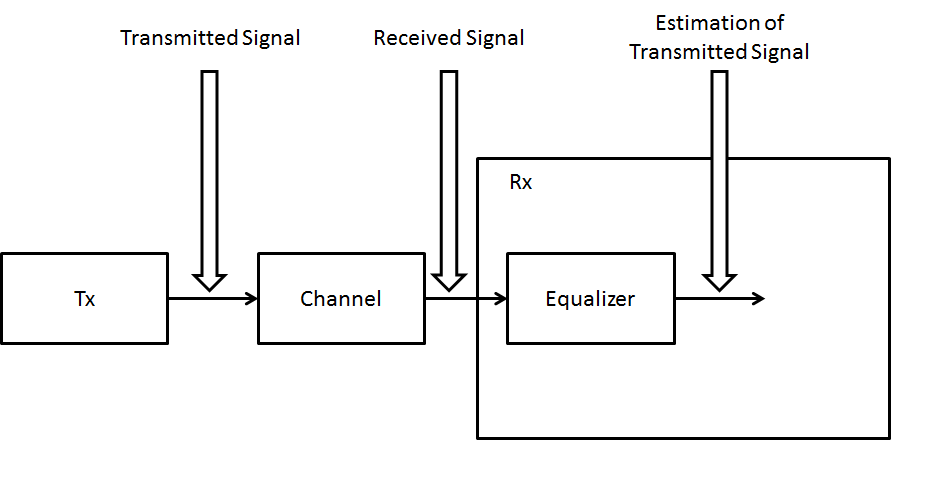I am having difficulty in trying to understand the working mechanism of an equalizer. Please correct me where wrong.
Mechanism of an Equalizer - The purpose of an equalizer is to reduce intersymbol interference due to noise and fading effect. A linear equalizer is a filter that can undo these channel effects. When the channel coefficients $w$ are unknown, we perform blind equalization. In this scenario, we first estimate $w$ and then apply an equalizer.
The output of an equalizer is a delayed version of the transmitted signal. This is what I do not understand. We need to find what is the input to the system, but the transmitted signal is not the input. What I mean to say,
let the channel model be a single input, single output moving average of order 2, MA(2): $y(n) = a_1*x(n-1) + a_2*x(n-2) + x(n) + \eta(n)$ where $x$ is the input data (unknown) and $\eta$ is an additive zero mean white Gaussian measurement noise; $n$ is the sample, $*$ is multiplication of the coefficient with the data.
If I do, out_eq = conv(w,y) (In Matlab) where $w$ are the estimates and $y$ is the received signal that is transmitted, then how come the input $x$ is obtained through this operation? Another way is not to use conv() and use an FIR filter because I read that linear equalizers are FIR filter. I can understand the part where we do $out_eq = y./w' = x$ but how is this similar to the convolution or using FIR filter?
Why Equalizers are linear filter? - posted as a new Question
Suggestion on what equalizer I should use for my case- I have a Rayleigh fading channel that is modeled as FIR filter. Let the impulse response / channel be $h$. Then the transmitted signal $tx(n) = h.*x(n) + AWGN$. I wish to apply Expectation Maximization and Kalman filter to estimate the $h$. Then, how do I equalize and which equalizer to apply and why?
UPDATE :
UPDATE -
Part (1) - Mechanism of equalizer
Reference - Book Blind Equalization & System Identification, batch processing Algorithm, performance & applications, by Chong-Yung Chi, Springer.
Chapter 4 defines blind linear equalization for Single input single output (SISO). Suppose that $u[n]$ is the source signal of interest and is distroted by SIS LTI system $h[n]$ via the data model:
$y[n] = x[n] + w[n]$ where $x[n] = h[n]*u[n]$ is the noise free signal and $w[n]$ is the additive measurement noise. The goal of designing an equalizer $v[n]$ is such that the output of the equalizer given by $e[n] = v[n]*y[n]$ approximates $u[n]$ as well as possible. $e[n]$ is called the equalized signal. The book says that we can do blind equalization through the following steps (a) estimation of $h[n]$ by means of blind system identification algorithm (b) design of a non-blind equalizer with these estimated parameters for the retreival of $u[n]$.
Confusion on Terminology problem and mechanism
: I was under the impression that the output of the equalizer is the source input to the system, as in case of an ideal equalizer we perform the operation out_equalizer = received_signal./channel_coefficients = h[n]*u[n] = y./hand looking at this equation, out_equalizer = u.
In other cases when we Constant Modulus ALgorithm, we use convolution or the FIR filter as
filter(estimates_channel_coefficients,1,received_signal)
But, according to the book, the output of the equalizer is not = received_signal./channel_coefficients. How will the operation $e[n]$ give me the input $u[n]$? Can you please explain how the equation for $e[n]$ is the output of the equalizer that gives the input $u[n]$.
Confusion - What is the output of the Equalizer- is it the transmitted signal (noise-free) or the input to the system?Your answer says that the output of the equalizer is the transmitted signal but the book says it should be the input to the system. But the transmitted signal is a noise free signal which is the convolution of the channel coefficients and the input source. The received signal is the input of your equalizer - Understood
you need to find the transmitted signal. It could be considered the input of your channel (the channel can be modeled as a FIR filter). - Can you elaborate on this a bit more? My understanding is say if the impulse response of the channel is modeled as a FIR filter, then how is the transmitted signal = input of this channel? Considering the MA(2) that I have put in the question, the transmitted signal is $\mathbf{y}$ but it is not the input to the channel. The input to the channel is $x[n]$.
PART (2) - Choosing an equalizer for my case
If the Rayleigh fading channel is a one tap FIR filter, then the ideal equalizer (dividing the recieved signal by estimated $h$) would work fine, based on your answer.
But , if it is an $m$ tap filter, then I should resort to some other techniques as you have said. Would another FIR filter as an equalizer be applicable? I know of Zero-forcing, MMSE techniques but was thinking of using the linear filter as most books say that equalizers are mostly FIR filters.
Thank you.

